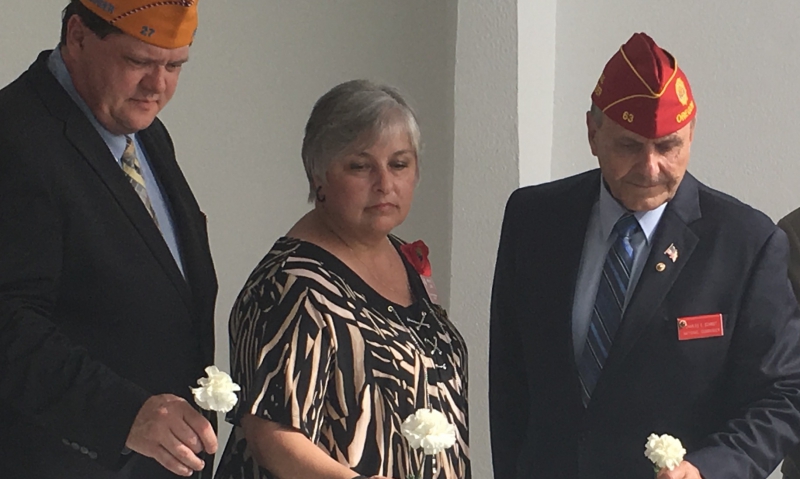
Pearl Harbor heroes: ‘They never took a knee’
Like every Pearl Harbor anniversary observance, the stars were the survivors and fallen heroes of the infamous attack. But keynote speaker Adm. Harry B. Harris received a prolonged standing ovation for his comparison of a controversial athlete to the veterans of that fateful day.
“You can bet that the men and women we honor today – and those who died that fateful morning 75 years ago – never took a knee and never failed to stand whenever they heard our national anthem being played,” said Harris, the commander of U.S. Pacific Command.
His speech was also a big hit with American Legion National Commander Charles E. Schmidt, who was in attendance at the Remembrance Day ceremony at Joint Base Pearl Harbor-Hickam.
“December 7, 1941 was a very important day to America and the world,” Schmidt said. “We honor and remember those heroes, but we must maintain vigilance so it doesn’t happen again. Unfortunately, it did happen again on 9/11. These are examples why The American Legion believes in a strong national defense and caring for veterans and their families.
“As our Preamble tells us, we are to preserve the memories and incidents of our associations in the Great Wars. We had a good showing here of The American Legion family, and I think that shows our resolve on this.”
The attack also had special significance to the family of American Legion Auxiliary National President Mary Davis. “Both of my parents were World War II veterans,” she said. “The reason they joined is because of the actions here at Pearl Harbor. I don’t think young people today understand how Pearl Harbor affected families. Until they have a personal connection, it’s just a lesson learned. Maybe that personal connection can come from having more veterans in classrooms.”
Schmidt, Davis and Sons of the American Legion National Commander Jeff Frain placed wreaths on behalf of their respective organizations at the USS Arizona Memorial. Frain, who hails from the Detachment of Arizona, led a contingent of several Sons members to Hawaii. Frain explained that the large delegation was needed, “to make sure that the Sons of The American Legion pays recognition and honors our fallen sailors and soldiers.”
The detachment of Arizona has supported the nearby Tripler Fisher House by donating $20,000 to the nonprofit facility over the last three years. This year, the detachment of California added another $200 donation.
“Being from Arizona, it’s a special honor to represent 366,000 Sons of The American Legion members at Pearl Harbor and visiting the Arizona,” Frain said.
Formed in 1932, it is very likely that at least some of the fallen veterans of Pearl Harbor were members of the Sons of The American Legion.
Although The American Legion supports a full accounting for all veterans that are listed as missing in action, Pearl Harbor offers a perfect illustration of the differences between accountability and recovery.
Pointing out the Naval tradition of allowing remains of fallen seaman to remain with their ship, Brigadier Gen. Mark Spindler of the Defense POW/MIA Accounting Agency told Schmidt and the Legion delegation, “I assure you, we will not dive on the USS Arizona. The U.S. Navy considers them entombed in the most sacred place they could be.”
Even so, Spindler stressed that DPAA takes its mission of accounting for those missing in action from every U.S. war very seriously. “DPAA didn’t send these people to battle,” he said. “The nation did and it’s a national responsibility. We want you in The American Legion to tell our story. This is about fulfilling our nation’s promise. No other nation does it at this level. Sometimes we are criticized for it. We don’t care.”
During his rousing morning address, which occurred during the same time as the attack 75 years earlier, Harris made an additional reference to the Star Spangled Banner and its relevance to Pearl Harbor veterans. “That fateful morning 75 years ago, they were about to conduct morning colors when they were surprised to hear the sounds of real ‘bombs bursting in air,’ instead of the reassuring melody of our nation’s anthem. At that ‘dawn’s early light,’ they ran to battle stations and to the sound of the guns, as they moved boldly to begin the defense of our country,” he said.
And while preparation and military readiness seem to be the overwhelming legacy that The American Legion and Pearl Harbor survivors believe people should take from the event, Carl E. Clark offers an additional lesson. A 100-year-old African American, Clark served in a military that was still segregated by race. A steward first class aboard the USSS Aaron Ward, he manned a firehouse fighting raging fires while kamikazes crashed on the deck of his ship.
“Pearl Harbor shows how hatred can be reversed after war,” Clark said. “We were so bitter. The Japanese were bombing us every day at Guadalcanal. We put Japanese Americans into concentration camps. But now we are friends. Good friends.”
Commemorations for the 75th anniversary of the attack continued throughout Wednesday in Hawaii, with the final event being the Pearl Harbor Memorial Parade through downtown Honolulu Wednesday evening. Participating in the nationally televised parade were approximately 25 American Legion family members from throughout the United States.
Schmidt said the exposure and the interaction he had with active-duty military members at the event were good examples of how The American Legion family can attract new members and grow.
He also recalled his morning visit to the USS Arizona Memorial. “The previous times that I visited the USS Arizona, it was seeping oil,” Schmidt said. “Today, the seepage was heavier. Like it was in mourning.”
